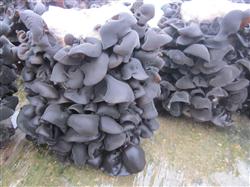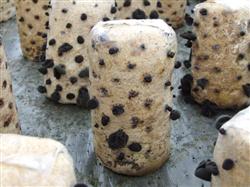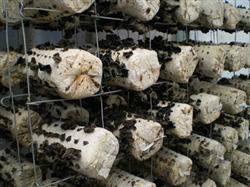How to plant black fungus?

How to plant black fungus? Please give an introduction to the cultivation of Auricularia auricula can refer to the following planting methods: first, seasonal arrangement Auricularia auricula is a kind of wood rot fungus, which belongs to medium-high temperature mushroom, its mycelial growth temperature range is 6: 35 ℃, the best is 22: 28 ℃; the general temperature range for hair growth and growth of ear slices is 15: 35 ℃, and the optimum temperature is 20: 28 ℃. Pingshan deep mountain area has unique cool climate resources, as long as the cultivation time is adjusted, except for the solar calendar in July, other times can be arranged. Spring ears are generally from mid-April to mid-May, and autumn ears are generally arranged from mid-September to mid-October. From June to August, the temperature is not easy to master, it is generally not easy to arrange, it is easy to form flowing ears, and the output and quality are not guaranteed. The production of bacterial bags can be calculated backwards according to the planned ear time, and it can generally be pushed forward for 45 minutes, but it should be calculated according to the conditions such as the base material, formula, culture temperature, the number of materials and the characteristics of fungus varieties. Master a principle: "better early than late." Second, formula one of the culture material: 85% sawdust, 10 jin of wheat bran, 5% superphosphate, gypsum powder, sucrose and so on. Formula 2: 65% sawdust, 20% cottonseed shell, 10% wheat bran, 5% sucrose, calcium superphosphate, gypsum powder and so on. Third, suitable cultivation varieties and plastic bag specifications: there are many varieties of Auricularia auricula suitable for planting in Pingshan County, such as Liaodan, Chaoyang series and so on. The cultivation bags of Auricularia auricula are smaller than other varieties, and it is better to use plastic bags with a width of 12 cm and a length of about 30 cm. Each bag contains about 1 jin to 1.2 jin of dry material. 4. base material treatment: select non-moldy hardwood sawdust and other raw materials, measure according to the formula, add a small amount of water and mix well. According to the texture of the raw materials and the temperature at that time, the pile is built for 2-4 days. One function is to make it fully absorb water and soften, to prevent sawdust spikes from piercing the plastic bag, and another function is that some miscellaneous bacteria spores begin to germinate under appropriate moisture and temperature conditions. It is beneficial to improve the effect of sterilization. After the material is finished, spread out the material pile, cool down while adding water to mix. First adjust the moisture content of the base material to about 63% (generally 100 jin of dry material to about 130 jin of water), and then bag it. Fifth, bagging: the material should be bagged in time after being mixed. Spread gunny bags or plastic film on the ground, or operate directly on the cement floor. With the bag sealed at the bottom, first put the two corners of the bag back, and then compaction while loading, so that the upper and lower parts are consistent and the reality is moderate. After the bag is packed, tie the other end with a rope. If possible, you can add cotton swabs and immediately put into the pot to sterilize. The problems that should be paid attention to when bagging: first, handle lightly when bagging, operate carefully, and be moderate, especially do not break the bag, once you do not pay attention to breaking the bag, it is very easy to cause miscellaneous bacteria pollution; second, while bagging, turn over the material pile to prevent moisture infiltration, resulting in inconsistent water content; third, the bags should be stacked flat to prevent moisture evaporation. Fourth, mix the material on the same day, bag and sterilize on the same day to avoid rancidity and breed miscellaneous bacteria. 6. Sterilization: all clinker cultivation needs to be sterilized. At present, atmospheric steam sterilization is used. During atmospheric pressure sterilization, when the temperature at the bottom of the steaming stove reaches 90-100 ℃, the time starts and lasts for 8-10 hours. When loading the pot, the material bag had better be stacked vertically, not misplaced. The sterilized material bag should be moved into the inoculation room or in a clean and ventilated place to cool down. When the bag temperature drops below 30 ℃, it can be inoculated. Seventh, vaccination: before vaccination, the inoculation room or inoculation box is disinfected with formaldehyde or aerosol disinfection box or spraying disinfection drugs. Vaccination personnel hands and tools should be disinfected with alcohol, vaccination is best for two people to cooperate, strict aseptic operation. Auricularia auricula is easy to be contaminated by miscellaneous bacteria, and it is difficult to cultivate. Alcohol lamp must be used when inoculating, and the whole operation should be completed in the aseptic area above the alcohol flame. This is the same standard as the strain production. Open the doors and windows immediately after vaccination to remove the dirty gas in the inoculation room. Eighth, bacteria management: using open-air cultivation, bacteria management must be carried out in a special place-culture room, which can use houses, simple sheds, and culture racks should be built in the shed, which should be all culture racks except management 3. Culture rack 3 has 4 layers, and generally 1 square meter of culture room can put 250 bacteria bags. The culture room was cleaned in advance, and the ground was cleaned according to the plan, 800 times of all diseases were sprayed without a trace, and the shed was sealed. After 2 days, the bacterial bag could be transferred into the bacterial culture management. On the third day of culture, the inoculation block can germinate, and after about 10 days, the growth rate of mycelium is accelerated, heat is produced in the bacteria bag, and carbon dioxide is excreted. Therefore, after 10 days, the ventilation rate should be gradually increased and the temperature can be appropriately reduced; after the 20th day, due to the peak of mycelium activity and the increase of biomass, the product temperature in the bacteria bag also reached the highest, so ventilation management should be strengthened. During the germicidal period, combined with management, we should focus on the inspection and removal of miscellaneous bacteria, and find out the bacterial bags of different colors, such as red, yellow, black, gray and white, and deal with them separately. After about 40 days, the bacteria can be finished. under general conditions, the temperature and humidity should be reduced as much as possible and ventilation should be strengthened after about 15 days. when the temperature is low, it can be extended to more than 20 days. it can be found that primordia appear in the inoculation blocks of most bacterial bags, and at this time, they can be transferred to ear management. Sixth, ear management to plant the ear, that is, the vertical bacterial bag is arranged on the surface with a single layer at an interval of about 20 cm, and the incision makes it out of the ear all over the body, and the incision can be zigzag, V-shaped, needle-shaped, and so on. The biggest advantage of this cultivation model is that there is no need to build mushroom shed, no ventilation and light management, saving early investment and reducing labor consumption. Generally, 8000 bags can be placed per mu, and one bag can produce 1.5 taels of dry ears. Because of open-air cultivation, water management is the focus of management, so it is necessary to set up sprinkler pipes to grasp the times and amount of water spraying according to climatic conditions. In general, it takes about 20 days for Auricularia auricula to be harvested from primordium to harvest. When it is found that the back of Auricularia auricula is getting more and more white and the front ear base appears white, it can be confirmed that it has matured, and when it is harvested in time. If the harvest is too early, although the quality of Auricularia auricula is high, it will affect the yield, such as harvesting too late, not only reduce the yield and affect the quality, but also cause diseases and insects due to a large number of ejection spores, and even lead to ear bleeding, resulting in unnecessary losses. When harvesting, it should be picked from the base, not only do not leave the ear base, but also try not to bring down the base material. Fresh ear after harvest, should be dried in time, generally can be dried in the sun, the method is to put a single piece of fungus, try not to overlap, in order to prevent adhesion. Auricularia auricula should be placed and packed in wooden cases or cardboard boxes, and do not use gunny bags or large plastic bags as far as possible, so as not to affect its commodity rate after being broken. Click to get more Auricularia auricula planting techniques
- Prev

What should Auricularia auricula pay attention to when it comes out of the ear?
What should Auricularia auricula pay attention to when it comes out of the ear? Please guide Auricularia auricula to produce high-quality and high-yield Auricularia auricula from May to October each year. Scientific management methods are very important. The key techniques for the management of Auricularia auricula are as follows: first, the temperature range to control the growth of ear slices is as follows.
- Next

What should I pay attention to when cultivating black fungus?
What should I pay attention to when cultivating black fungus? Please introduce black fungus is aerobic, wet, cold-resistant fungi. The relative humidity of the space is kept above 90% after opening. After 15 days, a large number of ear buds can be formed. After the formation of open ears, increase the amount of ventilation, 3~4 times a day, 1 hour each time, under the condition of ensuring relative humidity above 90%.
Related
- Fuxing push coffee new agricultural production and marketing class: lack of small-scale processing plants
- Jujube rice field leisure farm deep ploughing Yilan for five years to create a space for organic food and play
- Nongyu Farm-A trial of organic papaya for brave women with advanced technology
- Four points for attention in the prevention and control of diseases and insect pests of edible fungi
- How to add nutrient solution to Edible Fungi
- Is there any good way to control edible fungus mites?
- Open Inoculation Technology of Edible Fungi
- Is there any clever way to use fertilizer for edible fungus in winter?
- What agents are used to kill the pathogens of edible fungi in the mushroom shed?
- Rapid drying of Edible Fungi

